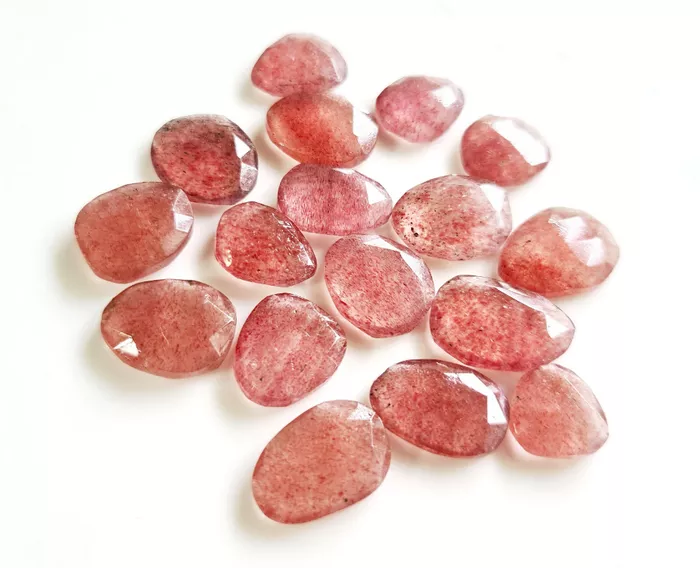Strawberry quartz, with its captivating hues of pink and red, has become a sought-after gemstone in the world of jewelry and crystal enthusiasts. However, like any other precious stone, it’s essential to verify its authenticity to ensure you’re getting what you pay for. In this comprehensive guide, we delve into the various methods and techniques to discern whether your strawberry quartz is genuine or not.
Understanding Strawberry Quartz
Before delving into the methods of authenticity assessment, let’s first understand what exactly strawberry quartz is. Strawberry quartz is a type of quartz crystal that owes its pinkish-red color to inclusions of various minerals, such as iron oxide or goethite. These inclusions give the stone its distinctive appearance, resembling the seeds of a strawberry, hence the name.
Visual Inspection: The First Step
One of the most straightforward methods to determine the authenticity of strawberry quartz is through a visual inspection. Authentic strawberry quartz typically exhibits a uniform distribution of color, with no visible bubbles, cracks, or irregularities. Hold the stone up to a source of light and observe its clarity. Authentic strawberry quartz will have a translucent to transparent appearance, allowing light to pass through it with minimal obstruction.
Inspect the surface of the stone for any signs of artificial enhancements or treatments, such as dyes or coatings, which may be used to simulate the appearance of genuine strawberry quartz. Genuine stones will display natural patterns and inclusions, while synthetic or treated stones may appear overly perfect or uniform.
Scratch Test: Assessing Hardness
Another method to authenticate strawberry quartz is by conducting a scratch test. While this test may not always be definitive, it can provide some insights into the hardness of the stone, which is a characteristic of quartz. Use a sharp object, such as a knife or a piece of glass, to attempt to scratch the surface of the stone. Authentic strawberry quartz, being a form of quartz, should not be easily scratched by common household items.
However, it’s essential to exercise caution when performing a scratch test, as scratching the surface of a valuable gemstone can diminish its aesthetic and monetary value. Consider conducting the scratch test on a small, inconspicuous area of the stone or seek the guidance of a professional gemologist if you’re unsure.
Density Measurement: Weighing the Options
Determining the density of the stone can also aid in verifying its authenticity. Genuine strawberry quartz will have a specific gravity ranging from 2.65 to 2.91, which is consistent with other varieties of quartz. To measure the density, you’ll need a scale that can accurately measure in grams and a container filled with water. Carefully weigh the stone in air and then in water. The difference in weight between the two measurements can help calculate the stone’s density.
Keep in mind that while density measurement can provide valuable information about the authenticity of strawberry quartz, it’s not always a foolproof method. Factors such as the presence of inclusions or impurities can affect the density of the stone, leading to potential discrepancies in the results.
Thermal Conductivity: Heating Things Up
Thermal conductivity testing can be another useful tool in authenticating strawberry quartz. Quartz is known for its low thermal conductivity, meaning it doesn’t conduct heat well. To perform this test, heat the stone gently using a flame or a heat source for a short duration. Then, touch the heated portion of the stone with your fingertip. If the stone feels warm quickly, it may indicate that it’s not genuine strawberry quartz, as quartz typically takes longer to heat up.
However, it’s essential to exercise caution when conducting thermal conductivity testing, as exposure to high temperatures can potentially damage the stone, particularly if it’s synthetic or treated. Use a low heat setting and avoid prolonged exposure to heat to minimize the risk of damage.
UV Light Test: Shedding Light on Authenticity
Utilizing ultraviolet (UV) light can reveal certain properties of the stone that may aid in determining its authenticity. Genuine strawberry quartz may exhibit fluorescence under UV light, emitting a faint glow in shades of pink or red. However, it’s essential to note that not all strawberry quartz will fluoresce, as this property can vary depending on the specific mineral inclusions present in the stone.
To conduct the UV light test, simply expose the stone to a UV light source and observe any fluorescence emitted. Keep in mind that fluorescence alone may not be sufficient to authenticate strawberry quartz, as other factors such as color, clarity, and inclusions should also be considered.
See Also: How to Tell if a Pink Diamond is Real
Expert Opinion: Seeking Professional Guidance
When in doubt, seeking the opinion of a qualified gemologist or jeweler can provide valuable insights into the authenticity of your strawberry quartz. Gemologists are trained to identify various gemstones and can conduct a range of tests using specialized equipment to determine their authenticity accurately. Additionally, they can provide certification or documentation verifying the authenticity of the stone, offering peace of mind to buyers.
Before seeking the opinion of a gemologist, ensure that they have experience with identifying and evaluating strawberry quartz specifically. Providing them with any relevant information about the stone, such as its origin, history, and any accompanying documentation, can also aid in the authentication process.
Conclusion
In conclusion, authenticating strawberry quartz requires a combination of visual inspection, hardness testing, density measurement, thermal conductivity assessment, UV light examination, and expert opinion. While no single method may provide a definitive answer, employing a combination of these techniques can help you make an informed decision when purchasing or evaluating strawberry quartz. By understanding the unique properties of this mesmerizing gemstone and utilizing the appropriate testing methods, you can ensure that your strawberry quartz is indeed the real deal. Whether you’re a collector, jewelry enthusiast, or simply appreciate the beauty of natural gemstones, knowing how to distinguish authentic strawberry quartz from imitations or treatments is essential for making confident and informed purchasing decisions.

